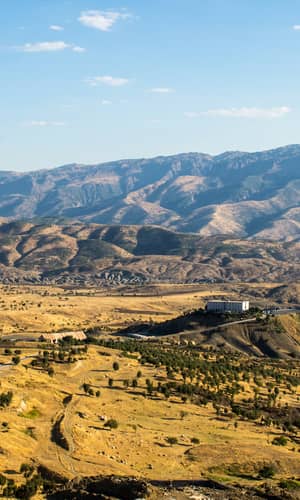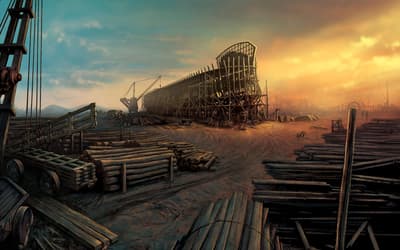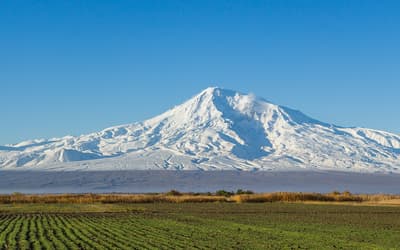The views expressed in this paper are those of the writer(s) and are not necessarily those of the ARJ Editor or Answers in Genesis.
Abstract
It is further shown that the application of ideational cognitive archaeology to the search for Noah’s Ark is flawed. The author’s Flood koine, as he calls his method, points to the Durupinar geological formation near Mount Tendurek in Turkey as the Ark. However, this “ark” did not slide down to its current location from between twin mountain peaks, as claimed by non-geologists, and therefore does not satisfy Powell’s Flood koine. According to geologists it was a rock formed into its boat-like shape in situ by erosional material flowing around it. Geological considerations therefore comprise compelling proof that this formation is not the Ark. In addition, there are geographical and chronological considerations. The Durupinar formation is not located in the mountains of Ararat (as the Bible stipulates), and it sits on a volcanic base that dates long after the Flood.
Keywords: Ideational cognitive archaeology, Noah’s Ark, Durupinar, Mount Tendurek, geology
Introduction
In this further reply to Powell (2022), it is shown that in spite of a second round of his explanations of ideational cognitive archaeology (Powell 2023), the fog has not cleared. (See Habermehl 2023 for my first reply.) His novel method of Ark searching has still landed us in the wrong place. Alas! The mistaken belief that the Durupinar formation is Noah’s Ark does not die, and we are doomed to keep refuting it over and over. Ideational cognitive archaeology will not save it.
Various Remarks
I find it odd that Powell claims that finding the Ark is not what his piece is mainly about, but that it is really about his Flood koine/ideational cognitive method. Our interests are clearly not running parallel, because what I am interested in is finding the Ark, whatever method is used. Having said that, I might like his method better if it actually did point to the Ark. But using unsupported assumptions and foggy arguments from multitudes of pagan sources, he asks us to settle for a pseudo ark stone formation. This does not recommend his method.
All of this comes from the leap of belief that we are required to make, that the Egyptian akhet (sun between twin peaks) for some reason represents the Ark, when in fact he already said that it represents the mound of creation. Somewhere in there I missed what the mound of creation has to do with Noah’s Flood.
Powell appears to believe that his twin-peak mound hypothesis overrides geology, geography, history, and archaeology. It would seem obvious that the ideas he promotes must be required to align with scientific disciplines.
The question is not whether or not Powell believes what the Bible says. I will accept his word on that. The question is why he accepts pagan literature sources to add to what the Bible says when looking for truth.
The Location of the Ark
With respect to the Ark’s location, the Bible only says that it grounded in the mountains of Ararat (also called Urartu) (Genesis 8:4). No other details are included. This has given rise to a great deal of confusion, because the unfortunately named Mount Ararat was not located in ancient Urartu/Ararat of Moses’ day. Nor was it called Mount Ararat back then, either. That name was only given to it in the Middle Ages. (See Mount Ararat 2023.) I mention this here because I find that many people still do not know this, and believe that Mount Ararat must be somewhere in the mountains of Ararat. (To clarify, Powell does not make this error.)
This distinction is important because the Durupinar site, which is near Mount Ararat, is not in the mountains of Ararat, either, in spite of claims to the contrary. The boundaries of Ararat/Urartu in the time of Moses leave the Mount Ararat/Tendurek region well outside of this area. It was only later in history (ninth to sixth century B.C.) that the greatly extended boundaries of the kingdom of Ararat/Urartu moved further north and included the Mount Ararat/Tendurek region (see fig. 1 in Habermehl 2008). This geographical fact eliminates consideration of the Durupinar formation as the Ark, and we can close the whole subject right here if we wish.
Powell lists ten stipulations about the Ark’s location taken from his pagan sources, but none of them are mentioned in the Bible with respect to finding the Ark and therefore do not have validity in his argument. (“Minni” from Powell’s no. 3 is mentioned in Jeremiah 51:27 in another context.)
There is no reason whatever to think that Noah’s descendants idolized a twin-peaked place where they supposedly first landed, as Powell claims. What the Bible says is that the people and animals left the Ark, Noah built an altar and offered burnt offerings on it, and the Lord smelled a sweet savor (Genesis 8). Then they left that place and eventually travelled to Shinar, a plain, not a mountainous place (Genesis 11).
Yes, I do indeed want to locate the Ark somewhere else. Guilty as charged on that one. The most likely location for the Ark is just north of Gizre, Turkey, near the Mount Gudi (Judi) mountain range, as I argue in Habermehl (2008).
Enter David Fasold
Powell accepts David Fasold’s claim that the boat-shaped formation slid to its present location from an original position between twin peaks some distance away (Fasold 1988, 88–14). However, geologists (Collins 2016; Snelling 1992) say that it did not slide to its present location from anywhere, but that it is a rock whose sides were shaped in situ by erosional material. This is an extremely important point. If the formation did not slide down from a higher valley, but is sitting attached to the ground in its original location, this wrecks Powell’s entire thesis that demands that the Ark landed between twin peaks.
We note here that Fasold was a sailor, not a geologist, and his claims about geology need to be taken with more than a grain of salt. Fasold’s credentials are that he served in the U.S. Merchant Marine (Fasold 1988, 5). As every researcher knows, it is important to choose references with care. Not all references are equal. Any conclusion that is hung on the peg of a shaky reference is itself likely to be a shaky conclusion.
Fasold did not continue to believe the Durupinar formation was the Ark right to his death in 1998, as Powell claims. He coauthored a paper with Collins, published two years before he died, showing that the Durupinar formation was definitely not the Ark (Collins and Fasold 1996, 439–444). However, sources claim that he entertained doubts just before his death (Corbin 1999, 429; Dawes 2000, 184; Deal 2005, 45–46). Collins (2015) is adamant that these doubts are not true, but that Fasold retained his belief that the formation was not the Ark right to the end.
Setting Straight the Record on Mount Tendurek
Powell spends quite a bit of space on attempting to prove that the Durupinar formation is not on Mt Tendurek itself. Technically, he may be correct.
Tendurek is a shield volcano about 250 mi2 in area (Mount Tendurek 2023). Powell’s measurement of 20 mi from the caldera (a small round area in the middle of this vast volcano) to the Durupinar formation does not tell us whether or not the formation is actually on the edges of the volcano itself. It is close enough that sources quoted by Wikipedia (Durupinar Site 2023) say that the formation is on Mt Tendurek (Avci 2007; Collins 2011).
Whether or not the Durupinar formation is actually on the edges of Mt Tendurek is of essentially no significance in our arguments, whatever Powell or anyone else wishes to believe. But the sources cited above do claim that it is on a volcanic base. It therefore dates far later than the Flood, as the Ark cannot have landed on any volcanic territory.
The limestone in the area is claimed by Powell to disprove volcanic origin of the nearby peaks, However, limestone is widely associated with volcanoes, as a google search easily shows. See, for instance, Deegan et al. (2016).
It would seem that Powell is straining at a gnat here.
Answering the Challenge of the So-Called Drogue (Anchor) Stones
Powell is so sure that the so-called drogue stones in nearby Arzap (Kazan) were stabilizers from the Durupinar “ark” that he challenges me to explain what else they could be. I accept his challenge. It is an easy one to answer and I do so with alacrity.
It is well known to archaeologists that these are standing stones (also called menhirs) with sighting holes, and that they are widespread in that part of the world. See for example, the Zorats Karer (Carahunge) field of stones in South Armenia, 100 mi to the east of the Durupinar site. There are about 223 stones there, of which 80 have holes (Gonzalez-Garcia 2015). Nobody is suggesting that these Zorats Karer stones were drogue stones!
The Arzap stones have holes close enough to the edge that the thin lip would break off from the weight of the stones (as much as 10 tons according to Collins (2015)), if a rope were attached to pull them. From this practical point of view, these could not possibly be anchor stones (Collins 2016). It is unfortunate that their original value as part of a standing stone formation is gone because many have been moved to area Christian cemeteries (Merling 1993). In addition, geologists say that these stones were made of local stone. They could not have been made by Noah elsewhere before the Flood (Collins 2016).
Powell believes that these were drogue stones because of claims by the same Fasold the sailor, who is no archaeologist, and this is a rather naïve error on the latter’s part. Supposedly Noah cut these stones loose as he was coasting in to land the “ark,” which is why they are some miles from the Durupinar rock formation (Fasold 1988, 176). For comparison, we show one of these stones from Arzap (fig. 1) and one from Zorats Karer (fig. 2).

Fig. 1. David Fasold stands beside an Arzap “drogue stone.” The crosses are believed to have been added later. Robert C. Michelson on en.wikipedia in conjunction with the SEPDAC Corporation, “David Fasold, a promoter of the Durupınar site, stands with a Drogue Stone in Arzap ([Kazan] Türkiye) (crosses are believed to have been added later),” https://commons.wikimedia.org/wiki/File:DrogueStoneFasold.jpg, GNU Free Documentation License.

Fig. 2. Zorats Karer menhir. Uncredited, “Zorats Karer: Menhir with Holes,” https://commons.wikimedia.org/wiki/File:Zorats_Karer_Menhir.jpg, GNU Free Documentation License.
The Architectural Design of the Ark
The Bible does not tell us what the design of the Ark was, but merely gives us the dimensions (Genesis 6:15). It does not even call it a boat or a ship. It calls it a tebah (Hebrew, a box) (Strong 1894 #8392). That word appears only one other time in the Bible, for the basket in which Moses’ mother hid him among the bulrushes of the Nile River (Exodus 2:3). (The Ark of the Covenant is called by a different Hebrew word, aron [Strong 1894 #717, a box]).
Although the Durupinar formation looks like a boat to us, the Ark did not necessarily look like one. This gives us leeway in imagining what shape the Ark was, whether boat-shaped, a rectangular barge (that might have a box shape), or a reed boat (Fasold favored the latter; see Fasold 1988, 284–286). Answers in Genesis has developed its own design, the amazing structure at the Ark Encounter. During my Ark research over the years, I’ve seen many varying depictions of the Ark. Admittedly my favorite is the delightful 6 ft model in the lobby of the Sehr-i-Nuh (Noah’s Ark) hotel in Sirnak, Turkey, where I attended a conference. In keeping with its Columbus-era style, this ark model sports three fine sets of sails! (See fig. 3.)

Fig. 3. Ark model in the lobby of the Seth-i-Nuh (Noah’s Ark) hotel in Sirnak, Turkey. The hotel’s own stylized Ark logo was on everything, including the room key holder card and the salt and pepper shakers. Photo: Anne Habermehl.
We will probably not know what the Ark actually looked like unless we find it and excavate. We may get a surprise. But the boat shape of the Durupinar formation most certainly does not make it Noah’s Ark.
Why Has the Durupinar Rock Not Been Excavated?
In all the years since the Durupinar geological formation first popped out of the ground in 1948, Turkey has not permitted any excavation at the site. Considering how important the Ark is for Christians, Jews, and Muslims, we might be taken aback at this lack of interest on the part of the Turks to prove beyond all doubt that this is the Ark. Excuses about lack of funds do not wash. By comparison, there is no lack of funds for the Gobekli Tepe and Karahan Tepe area. In 2021 there was an announcement that they will spend $14 million to excavate these and other sites (Yackley 2021). They will also spend $19 million dollars on excavation of 750 sites by the end of 2023 (Gundogmus 2023), but Durupinar is not on the list. We do well to be suspicious that the Turkish geologists know that the formation is not the Ark, as Collins suggests (Collins 2015). However, they want to keep the tourists coming, and they do not want to kill the goose that lays the golden eggs. Powell should be glad of this, as excavation will most certainly prove beyond all doubt that this object is not the Ark.
A Compelling Option to Ideational Cognitive Archaeology?
Powell is not in a position to demand that I offer a compelling option to his ideational cognitive archaeology. He does not seem to be aware that a very good compelling option has been around for a long time. It is called scientific thinking. I see no need to offer a new one.
He has dropped this novel concept like a pebble into the pond of a well-established scientific body of scholars who are used to dealing with facts. The onus is on him to show that his method stands solidly on its own two feet and produces results. So far he has not done so. I do not accept his Flood koine as valid because of the flaws in the reasoning he presents. My compelling alternative, scientific thinking, shows that the Ark is not at Tendurek at all, but is somewhere else.
Summary
Among the reasons why the Durupinar formation cannot be the Ark are:
- It is not in the mountains of Ararat, where the Bible says it is.
- It is probably a solid rock that formed in place, and is therefore not a boat.
- Claims supposedly supporting the Durupinar formation as the Ark, such as the misidentified drogue stones, do not hold up.
We conclude that Powell has not proven that ideational cognitive archaeology can be a means of locating Noah’s Ark. As he has applied it, starting his reasoning with an unproven assumption about the meaning of the sun between twin mountain peaks, he has arrived at the wrong location for the Ark.
References
Avci, Murat. 2007. “‘Noah’s Ark’: Its Relationship To the Telçeker Earthflow, Mount Ararat, Eastern Turkey.” Bulletin of Engineering Geology and the Environment 66, no. 3 (16 March): 377–380.
Collins, Lorence G. 2011. “A Supposed Cast of Noah’s Ark in Eastern Turkey.” https://noahsarkscans.com/articles/A%20supposed%20cast%20of%20Noah%E2%80%99s%20ark%20in%20eastern%20Turkey%20-%20Collins%20%282011%29.pdf.
Collins, Lorence G. 2015. “The Story of Noah’s Ark, Dogubayazit, Turkey: The Young-Earth Creationist’s Position, the Scientific Evidence, and the Involvement of “Arkeologist” David Fasold.” http://www.csun.edu/~vcgeo005/YECark.pdf.
Collins, Lorence G. 2016. “Noah’s Ark Near Dogubayazit, Turkey?” Perspectives on Science and Christian Faith 68, no. 4 (December): 218–228.
Collins, Lorence, and David Fasold. 1996. “Bogus ‘Noah’s Ark’ from Turkey Exposed as a Common Geologic Structure.” Journal of Geosciences Education 44, no. 4: 439–444.
Corbin, B. J. 1999. The Explorers of Ararat and the Search for Noah’s Ark. Long Beach, California: Great Commission Illustrated Books.
Dawes, June. 2000. Noah’s Ark: Adrift in Dark Waters. Belrose, Australia: Noahide.
Deal, David Allen. 2005. Noah’s Ark—The Evidence: Untying the Knott of the Gordurian Mountains. Muskogee, Oklahoma: Artisan.
Deegan, Frances M., Valentin R. Troll, Martin J. Whitehouse, Ester M. Jolis, and Carmela Freda. 2016. “Boron Isotope Fractionation in Magma via Crustal Carbonate Dissolution.” Scientific Reports 6 (4 August): 30774. https://doi.org/10.1038/srep30774.
Durupinar Site. 2023. Wikipedia. https://en.wikipedia.org/wiki/Durup%C4%B1nar_site.
Fasold, David. 1988. The Ark of Noah. New York, New York: Wynwood Press.
González-Garcia, A. César. 2015. “Carahunge—A Critical Assessment.” In Handbook of Archaeoastronomy and Ethnoastronomy. Edited by Clive L. N. Ruggles, 1453–1460. New York, New York: Springer Science.
Gundogmus, Yildiz Nevin. 2023. “Turkiye Plans 750 Archaeological Excavation, Research Projects by Year’s End.” Anadolu Ajansi, 9 July. https://www.aa.com.tr/en/turkiye/turkiye-plans-750-archaeological-excavation-research-projects-by-years-end/2940511.
Habermehl, Anne. 2008. “A Review of the Search for Noah’s Ark.” In Proceedings of the Sixth International Conference on Creationism. Edited by Andrew A. Snelling, 485–501. Pittsburgh, Pennsylvania: Creation Science Fellowship.
Habermehl, Anne. 2023. “Decoding a World Navel ‘Visual Language’ Through Ideational Cognitive Archaeology: Comments” Answers Research Journal 16 (September 13): 463–466. https://answersresearchjournal.org/archaeology/decoding-world-navel-visual-language/.
Merling, David. 1993. “Has Noah’s Ark Been Found?” The Record (July 6): 6–7. https://www.tentmaker.org/WAR/HasNoahsArkBeenFound2.html.
Mount Ararat. 2023. Wikipedia. https://en.wikipedia.org/wiki/Mount_Ararat.
Mount Tendurek 2023 Wikipedia. https://en.wikipedia.org/wiki/Mount_Tend%C3%BCrek.
Powell, James. 2022. “Decoding a World Navel ‘Visual Language’ Through Ideational Cognitive Archaeology.” Answers Research Journal 15 (October 12): 301–337. https://answersresearchjournal.org/noahs-flood/solar-koine/.
Powell, James. 2023. “Decoding a World Navel ‘Visual Language’ Through Ideational Cognitive Archaeology: Reply.” Answers Research Journal 16 (September 13): 467–474. https://answersresearchjournal.org/archaeology/decoding-world-navel-visual-language-reply/.
Snelling, Andrew A. 1992. “Special Report: Amazing ‘Ark’ Exposé.” Creation 14, no. 4 (September): 26–38.
Strong, J. 1894. The Exhaustive Concordance of the Bible. New York, New York: Abingdon Press.
Yackley, Ayla Jean. 2021. “Discovery of Turkish 11,400-year-old Village Challenges Ideas of When and Why Humans First Settled Down.” The Art Newspaper, 17 November. https://www.theartnewspaper.com/2021/11/17/discovery-turkey-karahan-tepe.





